Don't mess with Big G. An update on the Parisian gallery scene
- (first published on artlifemagazine.com)
- Nov 20, 2012
- 6 min read
Updated: Mar 25, 2020
Paris- You can easily imagine Larry Gagosian's face when Thaddäeus Ropac announced his plans for a new exhibition space in the outskirts of Paris.
"Ted... Who?" And the Californian art mogul got his own XXL showroom faster than you can say "twelvegalleriesworldwide".
Who would ever dream of a Gagosian Gallery in Compton? Yet here it is in Le Bourget, following the same motto of art in the ghetto as Ropac's Pantin Gallery. For the Austrian dealer the abandoned ironware factory adds to two addresses in Salzburg and one in the heart of Paris.
Pantin and Le Bourget both lie in the bad banlieue, known by its postal code "93", typically used in expressions like "Yo, 93 representin', man!" or "Welcome to 93, your cell phone and wallet please."
Traditionally the only artistic actions taking place in the area are the "Days of the Burning Car", a local custom celebrated in irregular intervals and always an impressive spectacle that is broadcasted nationwide - mostly organised in connection with full contact sports involving two teams of varying size. Comparable to a rugby squad opposing American Football players, only one side carries helmets and body armour; the use of weapons of all kinds is unrestricted.
Contemporary Art is definitely not what you think of in the first place when hearing "93".
On the other hand it is widely known that part of the art world is placed on the end of a distribution chain which provides a regular source of income for "93"-residents. The district is an important transhipment place for South American and Northern African goods that find their way into art academies, gallery openings and nightclub restrooms. So yes, maybe there is a match after all.
By pure coincidence Gagosian Le Bourget opened only days after Ropac Pantin, the inaugural exhibition will last one day longer and both are showing works of Anselm Kiefer. Let's get ready to rumble.
In the blue corner solid Austrian wealth, traditional K&K pomp, tailcoats and castles. In the red corner self-made Californian-Armenian Bling Bling, Hollywood glamour, Jeans and T-Shirts.
Schwarzenegger vs. Chuck Norris, Bigfoot vs. Wolpertinger, Diddy vs. DJ Ötzi? Ok, I'll stop here (clichés are fun, aren't they?).
Or rather proceed to the important question: Whose is bigger?
The bare figures are unambiguous: 4700 sq. m. (50 590 sq. ft.) to 1650 sq. m. (17 760 sq. ft.) for Thaddäeus Ropac. However, even in this context it is not only size that matters.
Gagosian plainly profits from the publicity created by his choice of Jean Nouvel for an architect - a clear win over Buttazoni&Associates on Ropac's side (scusi, signore!). Furthermore the Austrian gallery moved to a complex of four buildings, of which only two will serve for exhibition purposes; the gigantic surface thus needs to be seen in context. Which certainly does not mean it is not impressive! In the main hall we find a copy of the triangular glass roof that is a well-known eye-catcher of Ropac's inner-city gallery in Rue Debelleyme, marketing minds would talk about brand recognition values.
Le Bourget on the contrary hosts a small airport for cargo and private flights. Larry Gagosian rented an empty hangar to show his art in and this simply has style. He knows his customers are beyond cars.
On a certain level even Net Jets has a stain, is no longer classy enough - if you buy at Gagosian you don't rent a jet. You own it.
This is progress, indeed: From drive-by shootings to fly-in galleries (not duty-free, as goes without saying). People like you and me who first have to take the regional RER train and then a bus to get there, are kept on the outside of a high fence protecting the airport.
The battle of spaces ends with a draw.
Finally, there is art.
Anselm Kiefer is without a doubt one of the greatest artists of our times, and he visibly made an effort to adapt the exhibitions to the respective galleries. At Thaddäeus Ropac we find metaphors of suffering, images of remorse and remembrance, in your face like a Thomas Bernhard piece. It seems impossible to escape the ambiance of tragedy and death.
Maybe Kiefer still hopes to reach certain heirs among Austro-German art collectors. Entitled "The Unborn" he confronts us with death camp still lifes and preserved embryos. Destroyed, exploded typewriters recall unwritten biographies, a scythe cuts cooped up crop plants.
"Unborn" are the children of the murdered and those who had not the chance to know life. There is an allusion to complete destruction of a human being; dissolved in ashes the victims' fate and every trace of existence were completely annihilated - as if never born. The paradoxical depiction of non-existence fights against oblivion. Numerous other motives and histories are woven in, of religion and alchemy, of witchcraft and descents to hell (so the press release tells us).
As usual, Anselm Kiefer uses writings as a key element; one term frequently reappearing here is "Mutterkorn". Losing all its poetical power in the English translation "ergot", the German word literally means "Mother-Corn". It refers to a parasitic fungus living on cereals that was responsible for medieval epidemics of ergotism, or "Antoniusfeuer" ("Fire of Saint Anthony") in the artist's native tongue. The illness is characterised by leprosy-like gangrene of fingers and toes together with powerful hallucinations. "Mutterkorn" is the natural substance that has later been explored and synthesized by Swiss chemist Albert Hoffmann who baptised the final outcome of these researches Lysergsäurediethylamid, or short: LSD. We may think of fascism as a secular "promise of salvation" sold as utopia and turning into real hell worse than any bad trip.
Like many poisons "Mutterkorn" has also played a role in medicine for centuries, if not millennia - though to a disputable means. The name derives from the substance's ecbolic potential; traditionally it was used for abortions: "The Unborn", once again.
This is Kiefer live, before realising it you get lost in meanings and references. Think about Paracelsus and theories on poison, take a turn on the next crossroads to alchemy, pass via those preserved embryos at the Golem and Homunculus in Goethe's Faust 2, then you are... Well I don't know, where you are. But it is dark there, and no Enlightenment in sight.
Much has been written about Kiefer's efforts to reconcile German and Jewish culture, he is a veritable expert in Kabbalistic and Christian mysticism, but he cares not in the least about Moses Mendelssohn and Gotthold Lessing. Anselm Kiefer stands for a turn to pre-rationalism that has been quite common amongst German intellectuals of his generation in a fatalistic reaction to the dialectics of Enlightenment postulated by Theodor Adorno (strongly simplified: rationalism itself led to the Holocaust). Of course this does not in any respect diminish his artistic genius, a certain non-rational attitude is best suited for artistic creation in general.
Non-rational does not mean non-intellectual, there are many layers and components to Anselm Kiefer's works. The problem with secret knowledge is its secrecy... Only a minority will be able to fully seize and interpret all of the symbols, which is why it is all the more essential to keep the presentation simple. As stated above, Kiefer succeeds in this task. His works are "understandable" by everybody; you don't need to know to feel them. A minimum of information suffices to perceive overall meaning and atmosphere, they already work out on the emotional level. For the expert the pleasures of decryption and confirmed insider status come as an additional benefit.
One last point: as usual there are many verses by Paul Celan written over the canvasses and probably it is better if you do not understand German, as otherwise you might get carried away from Kiefer's works to reflections over the poet. It is a thin line between emotion and false pathos and the fluctuations between genius and hilarious kitsch in Celan's work in general and in the quotations Anselm Kiefer chose in particular, are astonishing. Sometimes you just wish Celan for his part had listened to Adorno's dictum of the impossibility of writing poems after Auschwitz.
At Gagosian, the exhibition is called "Morgenthau Plan", the name of a project to make tabula rasa after World War 2 and eradicate Germany, or more precisely turn it into a preindustrial agricultural state. A proposition, that today may sound appealing to the ears of Greek people (sorry: European joke), but has never been realised because of predicted famines. As it was discussed before the war was actually over - though the allied victory was already certain by that time - and leaked to the American press from where it found its way to German propaganda, it was immediately feared to be counterproductive by decreasing the remaining German troops' readiness to surrender.
An installation shows a field of (artificial) golden wheat plants "escaping" its metal cage. The lock is broken, nothing withstands basic human needs any more. The paintings that complete the exhibition are held in significantly brighter colours than those at Thaddäeus Ropac, they lack the symbols of death and appear rather optimistic. After the darkness the future was open, the post-war era marked a new starting point of unlimited possibilities. The Morgenthau Plan's non-implementation laid the foundations for a prosperous and peaceful future (it was "unborn").
Its abandonment was the first step to reconciliation, a hand reached out instead of legitimate revenge.
Anselm Kiefer "Morgenthau Plan", Gagosian Gallery Le Bourget,
19 October 2012-26 January 2013
Anselm Kiefer "Die Ungeborenen", Galerie Thaddäus Ropac Pantin,
14 October 2012-27 January 2013

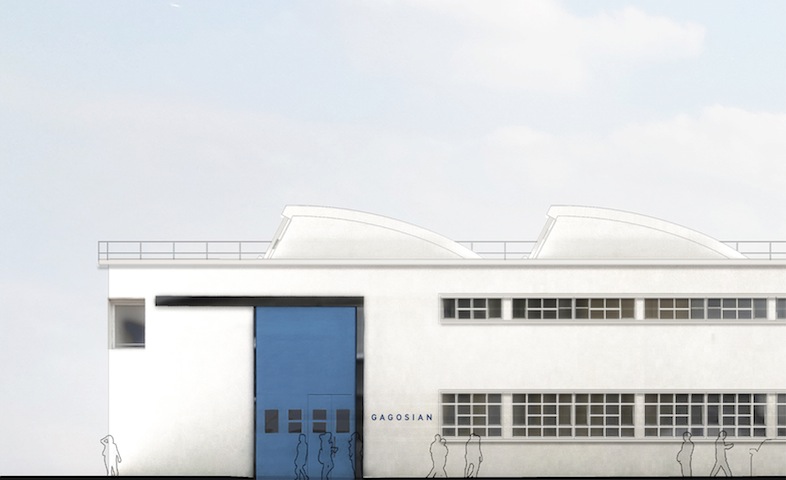

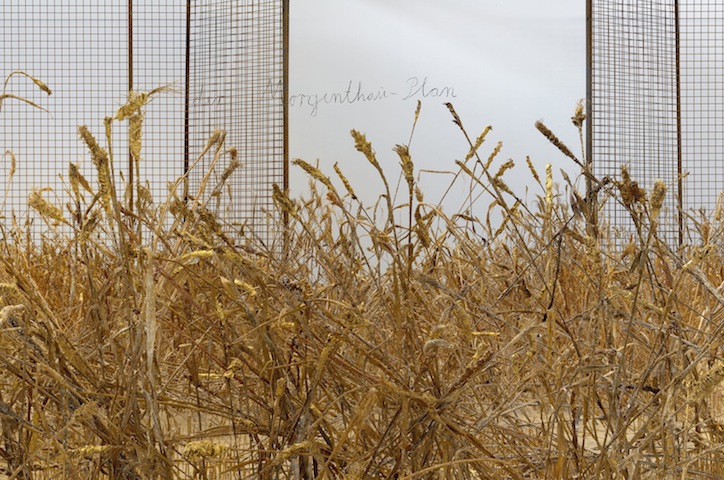

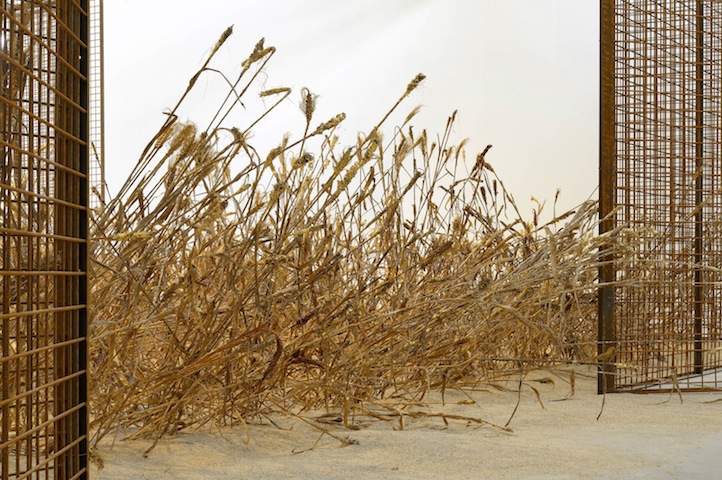

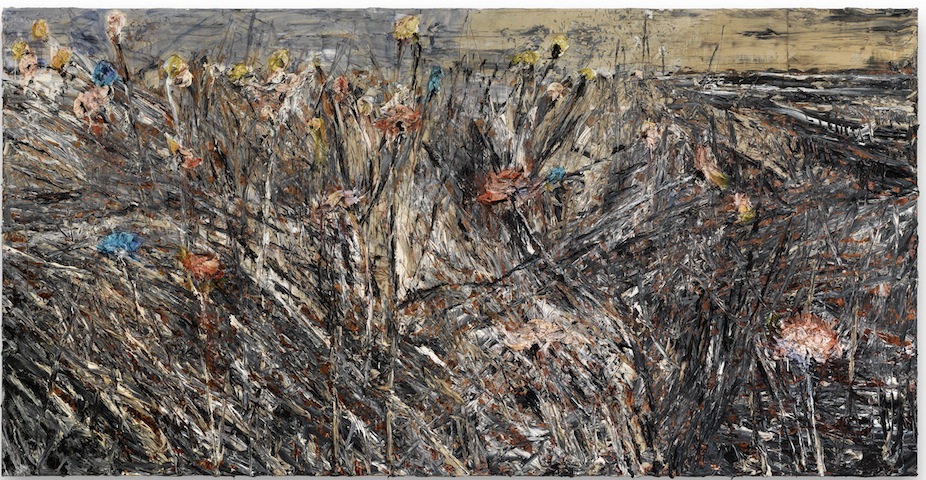
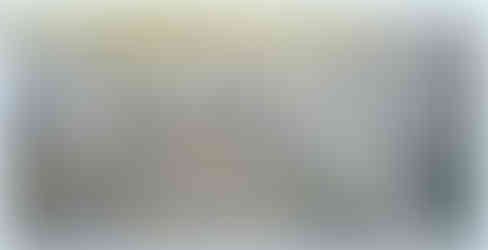

Comments